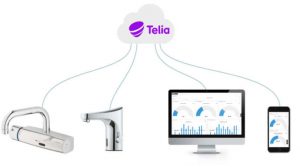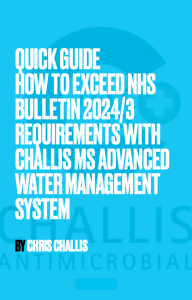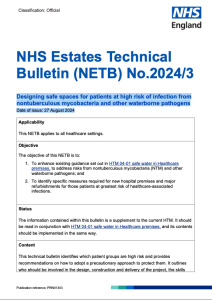1. Introduction
Purpose of the Bulletin
The NHS Estates Technical Bulletin No. 2024/3, issued on 27 August 2024, offers updated guidelines to improve water safety in healthcare environments, particularly where vulnerable patients are at heightened risk. This bulletin focuses on preventing infections caused by waterborne pathogens, including nontuberculous mycobacteria (NTM), with an emphasis on compliant water system design and monitoring, specifically regarding the temperature and flow of water from outlets such as taps and showers.
Key Risks and Focus Areas
The bulletin identifies specific requirements for reducing infection risks in showers and taps. Ensuring consistent, safe water temperatures and minimising stagnation are critical areas for compliance, as stagnant, improperly heated water can harbour NTMs and other pathogens.
Relevance to Healthcare Estates Managers
Estates managers are key players in implementing these infection control standards, as they have a direct impact on the safety and functionality of water systems. The bulletin’s guidance assists managers in creating environments that are safer for high-risk patients and meet strict regulatory standards for healthcare water safety.
2. Understanding Nontuberculous Mycobacteria and Other Pathogens
Overview of Waterborne Pathogens
Waterborne pathogens, including NTMs like Mycobacterium avium and Mycobacterium intracellulare, can thrive in water systems where temperatures are not adequately controlled. NTMs pose severe infection risks, particularly respiratory infections, for immunocompromised patients, making temperature monitoring a crucial element in their control.
Transmission Pathways in Healthcare Settings
NTMs and other pathogens spread through water droplets released from outlets such as showers and taps. Without adequate temperature regulation and flushing protocols, water in these outlets can become a medium for pathogen growth, putting patients and healthcare staff at risk.
High-Risk Environments
In high-risk environments such as intensive care units and oncology wards, patients with compromised immune systems face greater risks from waterborne pathogens. Estates managers must apply rigorous temperature and flow control to mitigate these risks effectively.
3. Bulletin Compliance Requirements for Safe Design
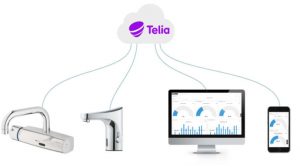 Primary Bulletin Recommendations
Primary Bulletin Recommendations
The bulletin mandates specific temperature control measures for showers and taps to prevent pathogen growth. Maintaining consistent temperatures within a range that is hostile to NTMs and other pathogens is essential. Estates managers must also monitor these temperatures actively, as even brief drops below the recommended range can lead to pathogen proliferation.
Temperature Monitoring and Compliance
Meeting these requirements demands real-time monitoring and reporting of water temperatures at outlets, a key compliance point under the new bulletin. Monitoring temperature at every outlet ensures consistent pathogen control and demonstrates compliance with NHS safety standards, protecting high-risk areas effectively.
Pathogen Control and Prevention
In addition to temperature control, the bulletin advises scheduled flushing, regular disinfection, and periodic maintenance of water systems to prevent stagnation. Together, these measures reduce the risk of pathogen spread and support a safer healthcare environment.
4. The Challis FM Mattsson Water Management System: Exceeding Compliance Standards
 System Overview
System Overview
The Challis FM Mattsson water management system is engineered to meet and exceed the NHS’s strictest water safety guidelines, with integrated temperature monitoring as a core feature. This system provides estates managers with real-time data on outlet temperatures, a critical tool for pathogen prevention and regulatory compliance.
Temperature Monitoring and Control
By continuously monitoring temperatures at each water outlet, the Challis FM Mattsson system ensures that water remains within safe temperature ranges. Automated alerts notify managers of any deviations, allowing immediate corrective action and preventing pathogen growth. This feature supports both daily compliance and long-term safety for high-risk environments.
Exceeding Standards
Beyond meeting standard requirements, the system’s integrated monitoring capabilities offer additional safeguards. It not only helps healthcare facilities stay compliant but also supports proactive infection control, reducing the likelihood of outbreaks in high-risk areas.
5. Features of Challis FM Mattsson for Showers and Taps
Pathogen-Resistant Materials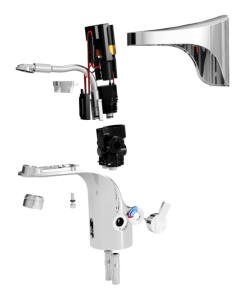
The Challis FM Mattsson system’s use of pathogen-resistant materials in taps and showers prevents microbial buildup. These materials are specifically selected to support healthcare water safety, in line with NHS standards.
Advanced Water Flow and Control Mechanisms
Effective water flow is essential for minimising the risk of stagnation. The system’s flow control mechanisms reduce stagnation in water outlets, further diminishing conditions that support pathogen growth.
Automated Safety Checks and Temperature Alerts
In addition to temperature monitoring, the system includes automated safety checks and alerts, allowing estates managers to monitor compliance continuously. This automation simplifies the process of maintaining safe water systems, providing real-time data and alerting for prompt responses.
6. Installation and Maintenance Best Practices
 Optimising for Compliance and Efficiency
Optimising for Compliance and Efficiency
Proper installation of water management systems is crucial to achieving consistent temperatures at all outlets. The Challis FM Mattsson system simplifies this process with best practices aligned with NHS standards, supporting optimal compliance.
Regular Maintenance Protocols
Maintenance activities, such as flushing and disinfection, are essential for pathogen prevention. The system includes prompts and reminders to support maintenance routines, making it easier for estates managers to ensure compliance with routine water safety standards.
Cost and Resource Efficiency
By automating temperature monitoring and maintenance alerts, the Challis FM Mattsson system optimises water usage and reduces waste. These efficiencies contribute to both financial savings and environmental sustainability, benefiting healthcare facilities overall.
7. Case Studies: Real-World Applications
Case Study 1: Intensive Care Unit Implementation
A large healthcare facility implemented the Challis FM Mattsson system in its intensive care unit, utilising its temperature monitoring features to ensure compliance. Real-time alerts helped the team maintain consistent temperatures, which led to a measurable reduction in pathogen-related incidents.
Case Study 2: Oncology Ward Application
In an oncology ward, the system’s temperature monitoring and automatic alerts helped maintain compliance with NHS standards, allowing estates staff to act quickly on any temperature deviations. The proactive response capabilities contributed to a safer environment for high-risk patients.
8. Benefits to High-Risk Healthcare Environments
Supporting Patient Health and Safety
The Challis FM Mattsson system provides high-level protection against waterborne pathogens, a necessity for facilities serving immunocompromised patients. By ensuring temperature compliance, the system directly supports infection control and patient safety.
Operational Advantages for Estates Teams
The automated monitoring and reporting features reduce manual monitoring requirements, providing estates teams with a reliable, compliant water management system. This also frees up time and resources for other critical areas of facilities management.
Long-Term Sustainability
The system’s efficiency contributes to long-term sustainability by lowering energy use through optimal temperature management and reducing water waste. This aligns with broader healthcare sustainability goals, offering both environmental and economic benefits.
9. Conclusion and Call to Action
With stringent guidelines now in place under NHS Estates Technical Bulletin No. 2024/3, temperature control and pathogen prevention in water systems have become critical for healthcare facilities. The Challis FM Mattsson system provides an advanced solution that not only ensures compliance but also supports proactive infection control.
To learn more about how the Challis FM Mattsson water management system can enhance safety in your healthcare facility, please contact us directly. We’re here to help create safer, pathogen-controlled spaces for high-risk patients and improve water management for healthcare estates.
Telephone: 01628 529024
FREE Download of our New Booklet Click Here
NHS Estates Technical Bulletin (NETB) No. 2024/3 Click Here
